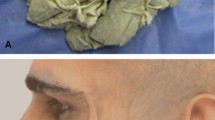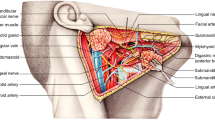Abstract
Drooling is a common symptom in parkinsonian disorders. Our aim was to assess the safety and effect of botulinum toxin when applied to parotid glands without ultrasound guidance for sialorrhea in parkinsonian disorders in a retrospective study with a long-term follow-up. We evaluated 53 patients (64.2 % male and 35.8 % female) with a mean age of 70.18 ± 9.25 years who were treated in our centre between 2007 and 2013. We analysed the mean dose, latency, effect duration, response and adverse effects of treating sialorrhea by injecting botulinum toxin type A (Botox) into the parotid glands without ultrasound guidance. A total of 41 patients with Parkinson’s disease, 6 with progressive supranuclear palsy, 4 with multiple system atrophy and 2 with corticobasal degeneration were included. The mean duration of the disease at onset was 10.51 ± 6.81 years and the mean sialorrhea duration was 1.99 ± 1.55 years. The initial dose used for each parotid gland was 14.53 ± 3.95 units of Botox, with a mean dose of 22.17 ± 8.76 units. There was an improvement after treatment in 65.22 % of patients with an average score of 6.85 ± 1.58 points on a scale from 0 to 10. The duration of the treatment effect was 4.38 ± 2.11 months, with a latency period of 10.06 ± 9.63 days. Adverse effects were mild and infrequent. Botulinum toxin is a safe and effective therapy for the treatment of sialorrhea in parkinsonian disorders and there is no requirement for ultrasound guidance. It has a rapid onset and lasting effect without requiring a high dosage.
Similar content being viewed by others
References
Asahina M, Vichayanrat E, Low DA, Iodice V, Mathias CJ (2013) Autonomic dysfunction in parkinsonian disorders: assessment and pathophysiology. Neurol Neurosurg Psychiatry 84:674–680
Mostile G, Jankovic J (2009) Treatment of dysautonomia associated with Parkinson’s disease. Parkinsonism Relat Disord 15:S224–S232
Proulx M, de Courval FP, Wiseman MA, Panisset M (2005) Salivary production in Parkinson’s disease. Mov Disord 20:204–207
Kalf JG, de Swart BJ, Borm GF, Bloem BR, Munneke M (2009) Prevalence and definition of drooling in Parkinson’s disease: a systematic review. J Neurol 256:1391–1396
Perez-Lloret S, Nègre-Pagès L, Ojero-Senard A et al (2012) Oro-buccal symptoms (dysphagia, dysarthria, and sialorrhea) in patients with Parkinson’s disease: preliminary analysis from the French COPARK cohort. Eur J Neurol 19:28–37
Chou KL, Evatt M, Evatt M, Hinson V, Kompoliti K (2006) Sialorrhea in Parkinson’s disease: a review. Mov Disord 33:2306–2313
Dressler D (2012) Clinical applications of botulinum toxin. Curr Opin Microbiol 15:325–336
Lakraj AA, Moghimi N, Jabbari B (2013) Sialorrhea: anatomy, pathophysiology and treatment with emphasis on the role of botulinum toxins. Toxins 5:1010–1031
Lagalla G, Millevolte M, Capecci M, Provinciali L, Ceravolo MG (2006) Botulinum toxin type A for drooling in Parkinson’s disease: a double-blind, randomized, placebo-controlled study. Mov Disord 21:704–707
Levy NS, Lowenthal DT (2012) Application of botulinum toxin to clinical therapy: advances and cautions. Am J Ther 19:281–286
Silvestre-Rangil J, Silvestre FJ, Puente-Sandoval A, Requeni-Bernal J, Simo-Ruiz JM (2011) Clinical-therapeutic management of drooling: review and update. Med Oral Patol Oral Cir Bucal 16:763–766
Jankovic J (2009) Disease-oriented approach to botulinum toxin use. Toxicon 54:614–623
Ondo WG, Hunter C, Moore W (2004) A double-blind placebo-controlled trial of botulinum toxin B for sialorrhea in Parkinson’s disease. Neurology 62:37–40
Kalf JG, Smita AM, Bloemb BR, Zwartsb MJ, Mullenersc WM, Munnekeb M (2004) Botulinum toxin A for drooling in Parkinson’s disease: a pilot study to compare submandibular to parotid gland injections. Parkinsonism Relat Disord 13:532–534
Breheret R, Bizon A, Jeufroy C, Laccourreye L (2011) Ultrasound-guided botulinum toxin injections for treatment of drooling. Eur Ann Otorhinolaryngol Head Neck Dis 128:224–229
Contarino MF, Pompili M, Tittoto P et al (2007) Botulinum toxin B ultrasound-guided injections for sialorrhea in amyotrophic lateral sclerosis and Parkinson’s disease. Parkinsonism Relat Disord 13:299–303
Dogu O, Apaydin D, Sevim S, Talas DU, Aral M (2004) Ultrasound-guided versus ‘blind’ intraparotid injections of botulinum toxin-A for the treatment of sialorrhoea in patients with Parkinson’s disease. Clin Neurol Neurosurg 106:93–96
Mancini F, Zangaglia R, Cristina S et al (2003) Double-blind, placebo-controlled study to evaluate the efficacy and safety of botulinum toxin type A in the treatment of drooling in parkinsonism. Mov Disord 18:685–688
Jongerius PH, Joosten F, Hoogen FJ, Gabreels FJ, Rotteveel JJ (2003) The treatment of drooling by ultrasound-guided intraglandular injections of botulinum toxin type A into the salivary glands. Laryngoscope 113:107–111
Porta M, Gamba M, Bertacchi G, Vaj P (2001) Treatment of sialorrhoea with ultrasound guided botulinum toxin type A injection in patients with neurological disorders. J Neurol Neurosurg Psychiatry 70:538–540
Nóbrega AC, Rodrigues B, Melo A (2009) Clinical does botulinum toxin injection in parotid glands interfere with the swallowing dynamics of Parkinson’s disease patients? Clin Neurol Neurosurg 111:430–432
Benson J, Daugherty KK (2007) Botulinum toxin A in the treatment of sialorrhea. Ann Pharmacother 41:79–85
Squires N, Wills A, Rowson J (2012) The management of drooling in adults with neurological conditions. Curr Opin Otolaryngol Head Neck Surg 20:171–176
Vashishta R, Nguyen SA, White DR, Gillespie MB (2013) Botulinum toxin for the treatment of sialorrhea: a meta-analysis. Otolaryngol Head Neck Surg 148:191–196
Naumann M, Dressler D, Hallett M et al (2013) Evidence-based review and assessment of botulinum neurotoxin for the treatment of secretory disorders. Toxicon 67:141–152
Moller E, Karlsborg M, Bardow A, Lykkeaa J, Nissen FH, Bakke M (2011) Treatment of severe drooling with botulinum toxin in amyotrophic lateral sclerosis and Parkinson’s disease: efficacy and possible mechanisms. Acta Odontol Scand 69:151–157
Guidubaldi A, Fasano A, Ialongo T et al (2011) Botulinum Toxin A Versus B in Sialorrhea: a prospective, randomized, double-blind, crossover pilot study in patients with amyotrophic lateral sclerosis or Parkinson’s disease. Mov Disord 26:313–319
Lipp A, Trottenberg T, Schink T, Kupsch A, Arnold G (2003) A randomized trial of botulinum toxin A for treatment of drooling. Neurology 61:1279–1281
Jost WH (1999) Treatment of drooling in Parkinson’s disease with botulinum toxin. Mov Disord 14:1057
Chinnapongse R, Gullo K, Nemeth P, Zhang Y, Griggs L (2012) Safety and efficacy of botulinum toxin type B for treatment of sialorrhea in Parkinson’s Disease: a prospective double-blind trial. Mov Disord 27:219–226
Respondek G, Roeber S, Kretzschmar H et al (2013) Accuracy of the national institute for neurological disorders and stroke/society for progressive supranuclear palsy and neuroprotection and natural history in Parkinson plus syndromes criteria for the diagnosis of progressive supranuclear palsy. Mov Disord 28:504–509
Stefanova N, Bücke P, Duerr S, Wenning GK (2009) Multiple system atrophy: an update. Lancet Neurol 8:1172–1178
Berardelli A, Wenning GK, Antonini A et al (2013) EFNS/MDS-ES/ENS [corrected] recommendations for the diagnosis of Parkinson’s disease. Eur J Neurol 20:16–34
Armstrong MJ, Litvan I, Lang AE et al (2013) Criteria for the diagnosis of corticobasal degeneration. Neurology 80:496–503
Friedman A, Potulska A (2001) Botulinum toxin for treatment of parkinsonian sialorrhea. Neurol Neurochir Pol 35:23–27
Acknowledgments
This work was supported by grants from the Ministerio de Economía y Competitividad de España (SAF2007-60700), the Instituto de Salud Carlos III (PI10/01674, CP08/00174), the Consejería de Economía, Innovación, Ciencia y Empresa de la Junta de Andalucía (CVI-02526, CTS-7685), the Consejería de Salud y Bienestar Social de la Junta de Andalucía (PI-0377/2007, PI-0741/2010, PI-0437-2012), the Sociedad Andaluza de Neurología, the Fundación Alicia Koplowitz, the Fundación Mutua Madrileña and the Jaques and Gloria Gossweiler Foundation.
Conflict of interest
Dr. Pablo Mir received fees for consultancy and support for conference attendances from Allergan and he received funds for unrestricted grants and conference attendances from Merz. The other authors declare that they have no conflicts of interest related to the contents of this article.
Author information
Authors and Affiliations
Corresponding author
Rights and permissions
About this article
Cite this article
Gómez-Caravaca, M.T., Cáceres-Redondo, M.T., Huertas-Fernández, I. et al. The use of botulinum toxin in the treatment of sialorrhea in parkinsonian disorders. Neurol Sci 36, 275–279 (2015). https://doi.org/10.1007/s10072-014-1950-y
Received:
Accepted:
Published:
Issue Date:
DOI: https://doi.org/10.1007/s10072-014-1950-y




